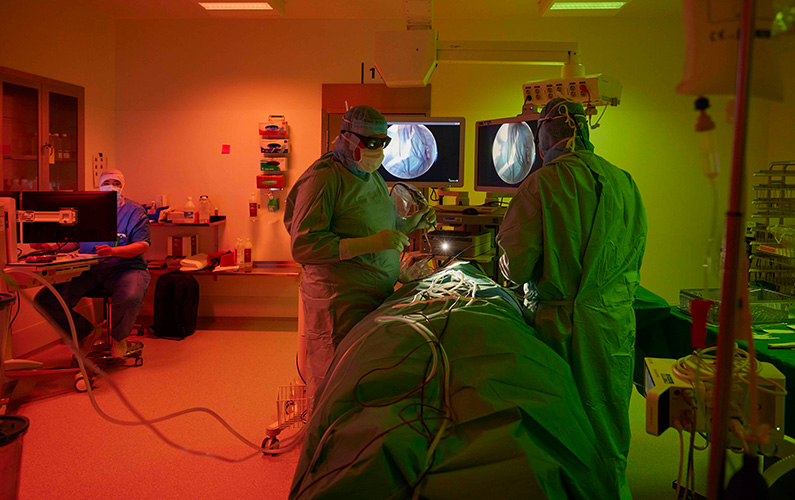Light is not only essential for our vision, it also carries a spectrum of colours that can impact us in various ways both physically and mentally - and it is precisely this knowledge that ergonomic lighting is based on. Let us explain how!
In essence, ergonomic lighting is a lighting solution specially designed for operating and examination rooms where screen images are used. The lighting is crafted to cater to the needs of all staff and patient groups simultaneously by dividing the room into coloured and white light zones. This creates different work zones, ensuring a productive and positive work environment for everyone. But what impact do the various colour nuances in ergonomic lighting have? And how do these colours affect the human eye?
Light spectrum and the impact of colours on the eye
The visible light consists of a spectrum containing all the colours of the rainbow. It ranges from violet, with the shortest wavelength, to red, with the longest wavelength. Each colour in the spectrum has its distinct characteristics and impacts us in different ways. In the healthcare sector, the strategic use of toned green and red lights has proven to be highly beneficial for healthcare professionals. The combination of these two colours enhances screen contrasts and overall comfort during surgical procedures. This is because green and red are complementary colours, meaning that when used correctly, they can be utilized to enhance and balance each other. By incorporating these colours into the design of ergonomic lighting, work environments can be created where all needs are supported, and all specialities can work harmoniously together.
Green light accentuates red hues
Green light falls in the middle of the visible light spectrum and possesses unique qualities that make it particularly beneficial during surgical procedures, especially those involving screens. Placing the toned green light behind screens displaying red images enhances the contrast and sharpness of the screen images. This makes it easier for surgeons to differentiate between various red anatomical structures such as organs and blood vessels. Additionally, the green light helps to reduce the contrast between the screens and the space behind them. It also tones down the contrasts in the room itself, minimizing disruptions to the surgeon's eyes from the surroundings.

In this way, the eyes relax more because they are not chasing contrast lines in the same way as if there were white light in the room behind the screen. Human eyes naturally seek out contrasts, and this can be avoided by using a green light instead of a white light. Furthermore, a green light behind the screens (at the right intensity) balances the luminance, making the screen appear clear and vibrant, while the space behind it is more subdued - without appearing black. With regular white light behind the screen, the room would likely overpower the screen, creating an undesirable focus. Conversely, if it is completely dark behind the screen, it becomes straining for the eyes to look at for extended periods. Therefore, the correct luminance balance between the screen image and the background is crucial for surgeons working on the screens.
Red light reduces reflections
By placing a toned red light behind the surgeon, glare on the screen(s) is reduced. This is because the red light from the fixture and the red images of organs and tissues on the screen are within the same colour spectrum and therefore balance each other out. Additionally, the red light reduces blur in the screen image unlike strong white light, which creates a lot of blur from reflections. This is because white light contains many blue colours (wavelengths), while red light is completely free of blue light. The red light also ensures a smoother and more comfortable transition between illuminated and dark areas in the operating room for the benefit of the staff's eye comfort.
A harmonious combination
The spectrum of colours in light encompasses a wide range of nuances, each of which - both individually and in combination with each other - impacts our productivity and well-being. It is this understanding of the light spectrum, the anatomy of the human eye, and the insight into the needs of healthcare professionals that together form the foundation of ergonomic lighting.

By creating a room divided into shades of red and green (at the right intensity), a cohesive space is formed that is both comfortable and relaxing to be in, striking a harmonious balance unlike a room illuminated by only one colour or white light.
Are you curious to learn more about the backstory of ergonomic lighting?
Read our interview with the mastermind behind the idea, Chief Physician Jesper Durup.

